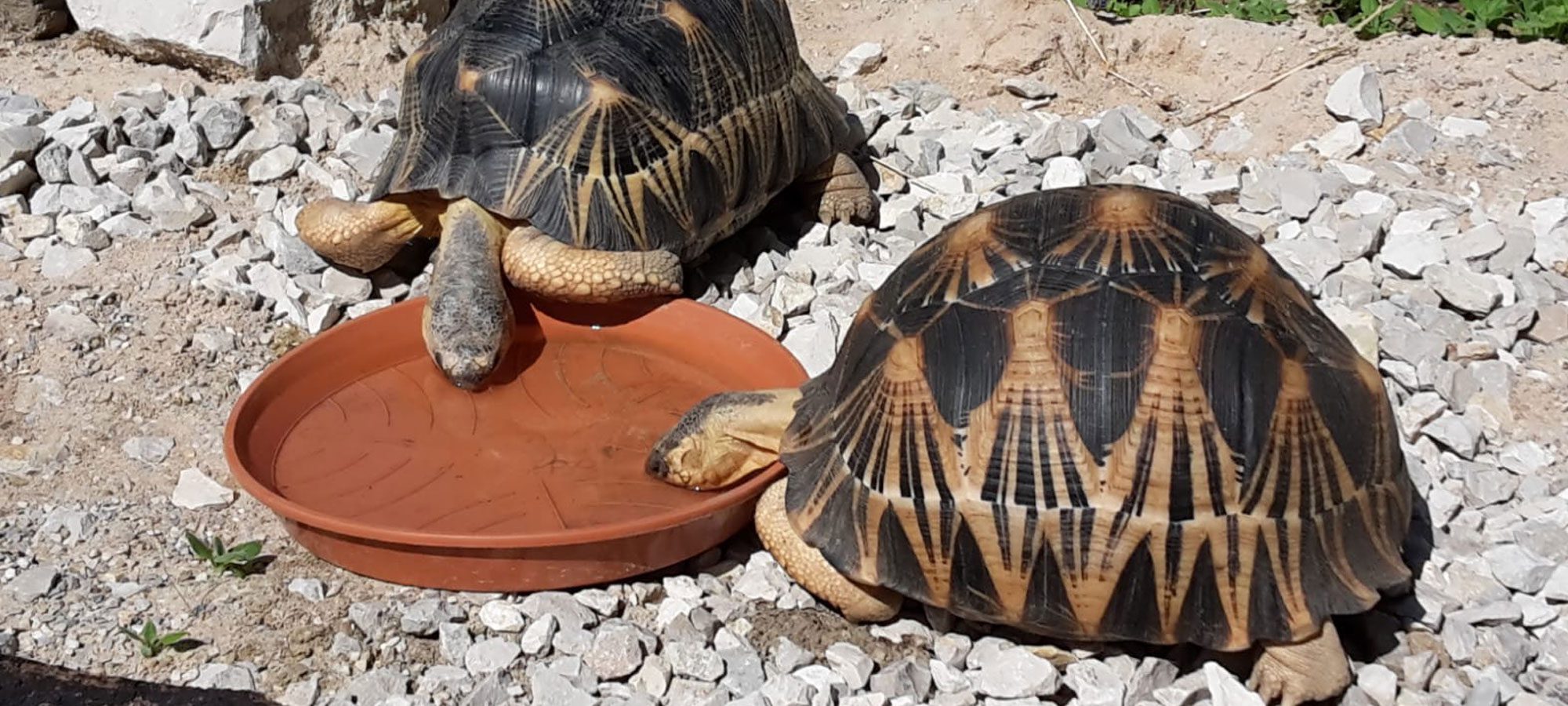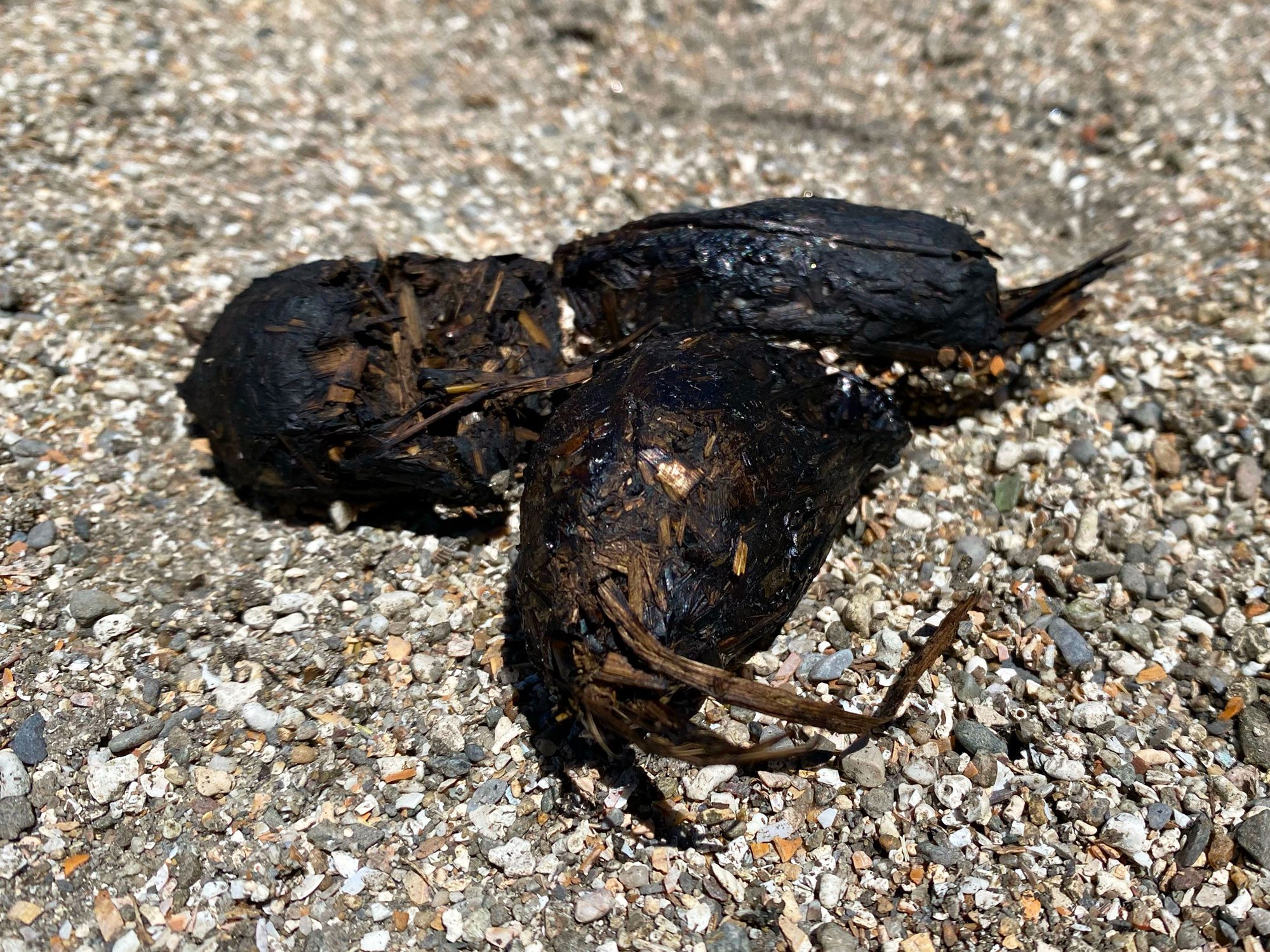Kontrollierte Wasserabgabe
Als typische Bewohnerin von semiariden Zonen ist der Wasserhaushalt von Astrochelys radiata an lange dauernde Trockenzeiten angepasst. Oft fällt in ihrem Habitat die gesamte Niederschlagsmenge eines Jahres in nur kurzer Zeit und der Rest des Jahres bleibt heiss und trocken. Wasser ist dementsprechend ein seltenes, kostbares Gut und wird von Strahlenschildkröten bei Verfügbarkeit immer gierig aufgenommen. Bei extremen und langen Dürreperioden ziehen sich die Tiere in Verstecke zurück, um in Trockenstarre Wasser und Ressourcen zu sparen. Besonders Jungtiere scheinen schneller und häufiger in diesen Energiesparmodus zu verfallen als adulte Tiere.
Astrochelys radiata kann selbst kleinste Wasserpfützen effektiv nutzen, indem sie Wasser auch durch die Nasenlöcher aufsaugen kann. Eine trinkende Strahlenschildkröte taucht meist den ganzen Kopf unter Wasser, um möglichst viel Flüssigkeit auf einmal aufnehmen zu können. Astrochelys radiata ist in der Lage, das aufgenommene Wasser in der Blase zu speichern, so dass sie auch längere Zeit ohne Trinkwasser auskommen kann. Immer wenn dem Tier wieder ausreichend Frischwasser zur Verfügung steht, wird das im Körper gespeicherte Wasser ausgeschieden. Je nachdem wie lange eine Strahlenschildkröte ohne Wasser ausgekommen ist, ist ihr Urin beim Wasserlassen konzentriert und von dunkler, rotbrauner Färbung.
Strahlenschildkröten decken einen Teil des Wasserbedarfs auch über wasserhaltige Nahrung ab. Es ist deshalb nicht ratsam Strahlenschildkröten täglich Wasser zur freien Verfügung anzubieten. Durch die physische Anpassung des Organismus an einen extrem trockenen Lebensraum ist es tatsächlich möglich, dass die Tiere bei permanentem Wasserangebot dauernd trinken, dabei häufig urinieren und dadurch regelrecht ausgeschwemmt werden. Dabei gehen viele wichtige Vitamine, Mineralien und Elektrolyte verloren. Durch das unkontrollierte Verfüttern von extrem wasserhaltigen Salaten und Gemüse wird die vermehrte Flüssigkeitaufnahme noch zusätzlich ungünstig gefördert. Strahlenschildkröten, die quasi mit Wasser «überdosiert» wurden, erkennt man gut am permanent klaren Urin und breiigen Kothaufen.
Wir bieten unseren Tieren einmal wöchentlich in grossen, flachen Schalen kontrolliert Wasser an. Dabei achten wir ganz genau, dass jedes Tier trinkt und prüfen auch regelmässig die Farbe und das Konzentrat des abgegebenen Urins sowie die Festikeit des Kots. Je nach Beschaffenheit und Aussehen der Ausscheidungen können die Wasserrationen nach oben oder unten korriegiert werden. Grosse, adulte Strahlenschildkröten können bei einer wöchentlichen angebotenen Trinkration grössere Mengen Wasser auf einmal aufnehmen. Bei zu geringer Luftfeuchtigkeit bzw. zu trockener Haltung entwickeln Strahlenschildkröten einen erhöhten Wasserbedarf.
Bei drohender Gefahr, Störungen und Stress (z.B. Transport) lassen Strahlenschildkröten meist das in der Blase vorhandene Wasser aus Abwehr und Protest los. Es ist wichtig, den Tieren nach einer Manipulation mit Urinverlust sofort wieder ausreichend Wasser anzubieten. Verstörte oder kranke Tiere können auch vorsichtig in warmen Wasser gebadet werden.
Wir nutzen ausserdem die kontrollierte Wasserabgabe, um das Innengehege länger sauber zu halten. Immer bevor wir den Indoorbereich reinigen, lassen wir alle Tiere zuerst ausgiebig trinken. Kurze Zeit später setzen alle Tiere in der Gruppe praktisch gleichzeitig Urin und Kot ab. Durch das synchrone Urinieren und Darmentleeren versäubern sich quasi alle Tiere in der Gruppe gleichzeitig und der Boden bleibt nach der Reinigung länger sauber. Dieser planbare und synchrone «Toilettengang» spart Zeit und sorgt für mehr Sauberkeit und Hygiene im Indoorbereich. Jungtiere können auch in flachen Schalen gebadet werden. Dabei setzten sie Urin und Kot direkt ins Wasser ab. Dadurch bleibt das Substrat im Innengehege länger sauber und muss weniger oft ausgewechselt werden.
Häufig gestellte Fragen zum Themenbereich Wasser
Der Organismus von Strahlenschildkröten ist relativ gut an Wasserknappheit angepasst. Einen Teil des Wasserbedarfs können die Tiere auch über die Aufnahme von wasserhaltiger Nahrung abdecken (z.B. Sukkulenten). Die Tiere nehmen bei Verfügbarkeit von Wasser immer mehr auf als gerade benötigt wird und speichern dieses in der Blase. Von diesem Wasservorat zehren die Tiere dann bei Trockenheit. Bei andauernden Dürreperioden verkriechen sich die Tiere in Verstecke und machen eine Art Trockenstarre um Wasser und Recourcen zu sparen. Vor allem Jungtiere scheinen bei entsprechend trockenen Bedingungen schneller und häufiger in diesen Energiesparmodus zu verfallen als adulte Tiere. Mit Hilfe dieser wasser- und energiesparenden Mechanismen, können Strahlenschildkröten auch mehere Monate problemlos ohne direkte Wasseraufnahme auskommen. Achtung: Eine zu trockenen Haltung in Verbindung mit tiefer Luftfeuchtigkeit hat aber für Strahlenschildkröten immer einen erhöten Flüssigkeitsbedarf zur Folge. Eine trockene Haltung bedeutet auch automatisch eine Stresssituation für die Tiere, welche sie unbedingt kompensieren wollen.



